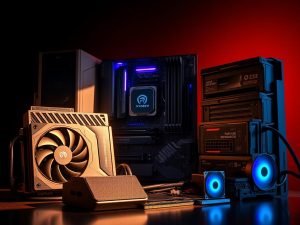Table of Contents
Constructing a custom PC can be thrilling, but the build time varies widely. For beginners, assembling components like the motherboard, CPU, and RAM may take 1.5 to 2.5 hours. Experienced builders often finish in under 90 minutes.
High-end systems with liquid cooling or complex wiring demand more effort. Custom loops can stretch the process to 3-4 hours. Prebuilt options, like those from Apex, save time but limit customization.
Unexpected delays, such as troubleshooting or driver installations, add to the total time. Tools like PC Part Picker help avoid compatibility issues, streamlining the installation.
Whether you’re crafting a gaming rig or a workstation, preparation is key. The right tools and patience ensure smooth performance from start to finish.
Understanding the PC Building Timeline
The journey from unboxing components to powering up a custom rig isn’t always linear. Delays like shipping backorders or troubleshooting misaligned parts can stretch build time from hours to weeks.
Average Build Time for Beginners vs. Experienced Builders
Newcomers often spend 2.5+ hours assembling motherboard, CPU, and RAM. Simple mistakes—like inverted PSU fans—add 45+ minutes. Experts, however, streamline the process to under 90 minutes.
Thermal paste application exemplifies this gap. A pea-sized dot suffices, but novices often overapply, requiring cleanup. “Pre-validated builds cut research time from weeks to minutes,” notes a Reddit hardware moderator.
Why Build Time Varies Widely
Cooling solutions dominate timelines. Noctua air coolers install in 20 minutes, while custom loops demand 3+ hours for leak tests. GPU scarcity—like 2023’s shortages—can delay projects by months.
RMA returns add 2-week waits. ASUS and MSI often backlog testing queues.
MiniTool’s data shows clean Windows installs take 30–45 minutes versus OS migrations.
Negative pressure setups (exhaust fans > intake) accelerate dust buildup. Correcting this post-installation wastes another hour.
Step-by-Step Time Breakdown: How Long Does It Take to Build a Computer?
Assembling a custom rig involves precise steps, each impacting total time. Start with unboxing components like HyperX Fury RAM—keep them in anti-static bags for safety. This phase takes under 10 minutes with proper precautions.
Next, align the motherboard in a Corsair 4000D Airflow case. Secure standoffs to avoid shorts. Experienced builders finish this in 15 minutes, while beginners may need 30+.
Power up using an EVGA SuperNOVA PSU for reliability. Samsung 980 Pro NVMe drives optimize via Magician software, cutting installation to 20 minutes. Stress-test with Unigine Superposition for stability.
Pro tip: Lian Li Strimer RGB cables add flair but extend setup by 15 minutes. Always research cases—like NZXT’s H1 recall—to avoid hazards.
Final benchmarks take 15 minutes. Seasoned pros average 1h10m; novices hit 2h20m. Proper tools and prep streamline the process.
FAQ
What factors influence the total build time for a PC?
The complexity of components, cable management, troubleshooting, and experience level impact duration. High-end gaming rigs with custom cooling often take longer than basic office systems.
How much faster are experienced builders compared to beginners?
Seasoned builders typically finish in 1–2 hours, while beginners may need 3–5 hours. Familiarity with hardware and efficient cable routing speeds up the process.
Does installing the operating system add significant time?
Yes, OS installation can take 20–60 minutes, depending on storage type (SSD vs. HDD) and whether drivers need manual updates.
What’s the most time-consuming part of assembling a computer?
Mounting the CPU cooler and managing cables often take the longest. Proper airflow optimization and PSU wiring require careful attention.
Can pre-built PCs save time over custom builds?
Absolutely. Pre-built systems eliminate assembly, but custom builds offer better performance and part selection for gaming or specialized workloads.
Do tools or workspace setup affect build speed?
A magnetic screwdriver, anti-static mat, and organized workspace reduce errors and save 15–30 minutes versus improvising tools.
How long should troubleshooting take if issues arise?
Minor problems (RAM seating, loose connectors) may take 10–20 minutes. Complex hardware failures can extend troubleshooting to hours.









